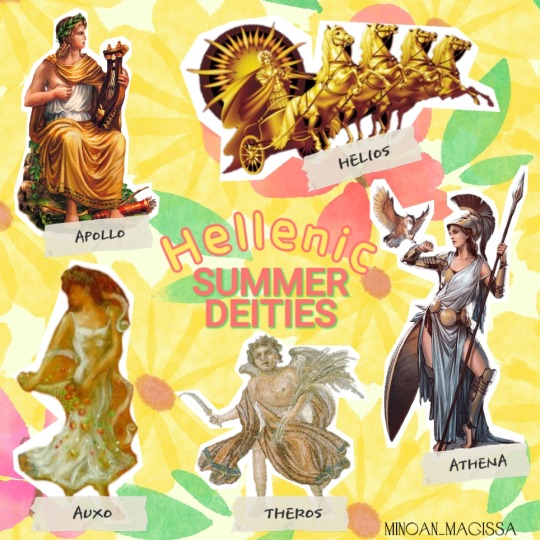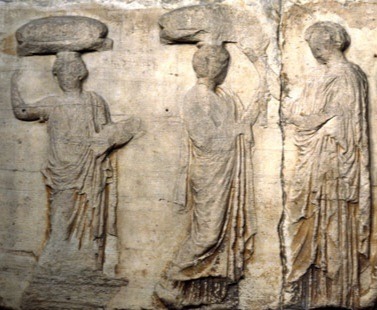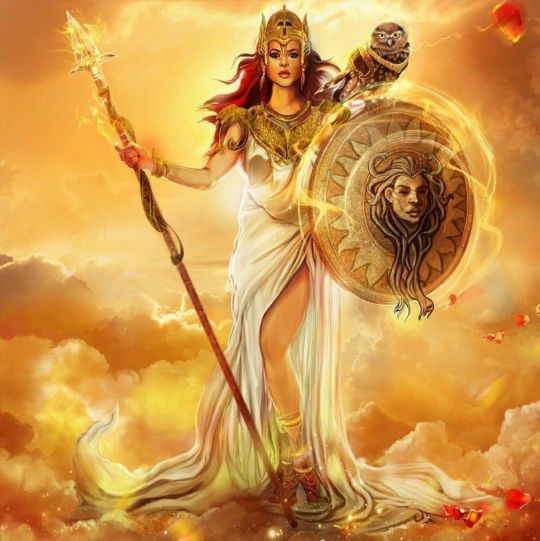#arrhephoria
Explore tagged Tumblr posts
Text
🦉Athena Masterpost: Festivals🦉

🐍 Masterpost Link 🐍
Last updated: Date of Publishing - Bibliography in Masterpost
This will just be a quick overview of the festivals, not intended to go in-depth. I may make additional posts later on with a bit more detail.

Panathenaia
28 Hekatombaion (July/August)
A New Year festival in Athens which takes place each year (Lesser Panathenaia) with a grander version every four years (Greater Panathenaia).
A nocturnal celebration, the pannychis, would take place before the festival, with a torch race and singing. The winner of the torch race would get to light the fire at Athena’s altar. During the Panathenaia there were various sports competitions but also musical contests, poetry recitals and pyrrhic dances. The prizes for these could be money, crown wreaths or amphoras of sacred olive oil depending on the event and age group.
Sacrifices of oxen would be made to Athena Polias, Athena Nike and Athena Hygeia and a massive feast would follow. Perhaps one of the most important parts of this festival was the presentation of the robe (Lesser Panathenaia) or tapestry (Greater Panathenaia) to Athena that would have been started in the Khalkeia.

Kallynteria and Plynteria
24 Thargelion (May/June)
Kallynteria was either a day of sweeping out of the temple, or a day where the cult image of Athena in the Erechtheion was adorned with jewelry or other items (the verb kallunein can mean both “adorn” and “sweep, scour”). Personally, I think that sweeping makes more sense due to the nature of Plynteria.
Plynteria took place the day after and was the day where the statue’s adornments were removed for washing by women of a noble family and it was veiled. There may have been a procession to wash the robes, and the statue itself might have been washed. This is often confused with another procession done by epheboi - that of a different cult image, the Palladion. This statue resided in a law court that oversaw the trials of crimes such as murder, and thus due to this exposure the statue was washed with sea water or carried to the sea to be washed clean of miasma. The day of Plynteria was considered apophras, an unlucky day of ill omen, because it was believed that the goddess was absent from the city on this day.
In modern practice, this might be a good time for a deep spring clean of your room or home and items. Donate what you don’t need or use or what has been sitting around “just in case.”

Arrhephoria
Shortly after Plynteria, the nocturnal festival of the Arrephoria takes place. This festival features the Arrhephoroi, two young girls who have lived about a year on the Acropolis, who on this day perform their last duty of priestly service. Pausanias is the main source for this rite, and describes how the Arrhephoroi carry baskets on their heads with secret things within that neither they nor the priestesses know. These baskets are carried through an “enclosure” near the sanctuary of Aphrodite ‘in the Gardens’ and down a natural underground passage. They then leave what they have brought and then pick up some other veiled thing to take to the Acropolis. Immediately after this, the young girls are discharged from service. The general belief is that this may have been some kind of fertility rite.

Khalkeia
Nine months before the Panathenaia is the Khalkeia (“Bronze”) festival on the last day of Pyanopsion. This was a festival of smiths and other artisans which honored Athena Ergane (“The Worker”) who presided over all crafts and also Hephaestus who was patron of those who used fire in their crafts. Evidence of dedications to Athena here include that from potters, a carpenter, a tanner, fullers, a scribe, a shipbuilder, a washerwoman, a baker, and a weaver, likely as a tithe from their profits, as craftsmen almost exclusively turned to Athena when it came to the pursuit of their crafting careers.
It was during this festival that the sacred robe for Athena, which would be offered at the Lesser Panathenaia, was started by women and the Arrhephoria. This may have also been when the similar sail-sized tapestry made by male workers was started. The robe and tapestry used to be considered the same item - older sources may indicate this but modern scholarship seems to agree that they were different.

#athena#athena deity#athena devotion#athena masterpost#helpol#hellenic polytheism#hellenic pagan#paganblr#panathenaia#kallynteria#plynteria#khalkeia#chalkeia#arrhephoria
17 notes
·
View notes
Text

"IDK Jamie, that Painting is awfully big... I just don't know" Just think at some point in Antiquity some sculpture didn't let something as small as that Piss-up a sale!
Today, June 9 our Fun Friends in #AncientGreece (#Athens) would have been throwing down with their Feast of #Arrephoria, instituted in honor of #Athena the #Greek Goddess associated with #wisdom, #handicraft, and #warfare
( https://en.wikipedia.org/wiki/Arrhephoria )
0 notes
Text
Some modernised ancient holidays I celebrate (and how) as a Deist/Hellenic Thoughtform Polytheist
•Lenaia - 3 through 5 Jan (watch comedy theatre, drink wine, spend time with family and friends, pray to Dionysus)
•Aphrodite Day - 14 Feb (pray to Aphrodite, bring offerings to altar, spend time with partner, exchange gifts with partner)
•Dionysia - spring equinox 2025-20-March (watch tragedy theatre, drink wine, decorate for spring, spend time with family and friends, pray and bring offerings to Dionysus)
•Arrhephoria - 3 June (clean house, bake apples, decorate for summer, spend time with family and friends, play board games, pray to Athena, bring offerings to altar)
•Summer Solstice - 2025-20-June (spend time with family and friends, drink, pray and bring offerings)
•Autumn Equinox - 2025-22-Sept (clean house, bake apples, decorate for autumn, pray)
•Samhain - 31 Oct-1 Nov (pray to Melinoë, bring offerings to the dead, spend time with family and friends, take down Samhain decorations on 1 Nov)
•Winter solstice - 2024-21-Dec, 2025-21-Dec (spend time with family and friends, bake pomegranate goat roast, decorate for winter, pray, bring offerings to Persephone and Hades)
• Haloa - 27 Dec (spend time with female friends, drink, pray and bring offerings to Demeter and Dionysus)
#there isn't an agreed upon Attic calendar as compared with the Gregorian Calendar#soooo i just kinda celebrate the holidays around their corresponding seasons#also Lenaia is extended this year because I have more plays lined up than I can watch in 3 days oof#I'm sure the gods understand
1 note
·
View note
Text
A standard dictionary defines mystic as a person who seeks to obtain unity with the Deity or the absolute or one who believes in the existence of spiritual truths that are beyond the intellect.
Per etymonline.com the word Mystic was mistike in Middle English and it means “spiritually allegorical, pertaining to mysteries of faith," and it comes directly from Latin mysticus meaning "Of or belonging to secret rites or mysteries." from Greek mystikos "secret, connected with the mysteries," from mystes "one who has been initiated, one initiated in secret rites.”
A mystes (pl. mystai) was initiated into a special cult or society and, as a result, knew things noninitiates did not. Many Greek cults and rituals had their secretive aspects: In the Athenian Arrhephoria, no one knew what objects were carried from the Acropolis, there were rites enacted in the cult of Dionysus that could not be revealed even in court.
I thought of mis-tick when I heard mystic recently. And mistake. A mystic can alter the wheel of time. Can cause it to mis-tick…Mystics see past the illusion of the matrix and can be an issue for the system. This universe is inside a space - time continuum, and the matrix is methodical. They are more likely to make an unpredictable choice or even create something new. One who truly follows the inner voice versus matrix programming can be difficult for the archons to control- pure consciousness is not something that can easily be predicted. Many of these social media algorithms are like trying to figure out consciousness.
I do feel those of us who follow our intuition give the controllers a whole lot more trouble than those of who follow along and don’t ask any questions. I feel that the older a soul is The more likely it is are to be a mystic or a gypsy I think of like jip the sea. You don’t give The system or the holy sea as much of your energy as the average person. You jip it.
I also feel there are many ancient souls currently incarnated on earth, souls that don’t often exist in the physical plane. Souls that have given the system issues before . Project looking glass was an operation done that could allegedly can see the future / on every single timeline humanity awakened or ascended in conscious awareness. The evil ones performing the operation stop doing it because they got so discouraged about the results. The Earth herself is a living being & she may very well be orchestrating an awakening. If we want to continue to reside within her, we’ve gotta vibe higher.
0 notes
Text
Summer Solstice Deities and Festivities

Summer Solstice/Καλοκαίρι/Θέρος/ Litha Blessings to my Northern Hemisphere friends! 🌞
Today also happens to be Arrephoria (Ἀρρηφόρια), a festival in honour of Athena. More on that later in the post!

Some info about the summer-related deities in the graphic:
☀️Auxo (Αὔξω) is one of the Horae (Ὧραι), and the goddess and personification of summer. She is also a protectoress of vegetation, growth, and fertility.
☀️Theros (Θέρος) is another personification of summer and is usually depicted as a winged boy holding an ear of grain in one hand and a sickle in the other. Theros is the word for summer in Ancient Greek.
☀️Athena (Ἀθηνᾶ) is the Olympian goddess of wisdom and warfare. Her main festival is the Panathenaia, which was celebrated during Hekatombaion in midsummer. The solstice also starts off with Arrephoria. Sinoika is yet another celebration during the summertime that honours her.
☀️Apollo (Ἀπόλλων) is the Olympian god of sunlight, healing, music, and poetry.
☀️Helios ( Ἥλιος) is the Titan god and personification of the sun. He is also the god of eyesight and oaths.
What I Did Today

I decorated my altar for the solstice and featured summer deities on the center of it.

I ate a (mostly) Mediterranean meal outside in the sunshine: kalamata olive spread, anaheim peppers, & extra virgin olive oil on gluten-free toast, gigantes beans with feta, and Persian cucumbers sprinkled with Greek oregano and paprika. 😋
I also did a lot of research to put together this post. That honestly took up most of my day. 😆
And now onward to Arrephoria!

Arrephoria (Ἀρρηφόρια) stems from the words "ἀρρητον" (mystery) and "φέρω" (I carry/bring). It is a midsummer fertility festival that honours Athena and takes place on the first day of the Estival Solstice.

In Ancient Athens, two young girls from aristocratic families were elected to reside as arrephoroi (άρρήφοροι: virgin acolytes of Athena Polias) at the Arrephorion on the Acropolis for a year at a time. Their main responsibilities included maintaining Athena's sacred olive tree and with the aid of other women, weaving Athena's new peplos.

On the evening of Arrephoria, the girls donned in white clothing placed what Athena's priestess gave them (a mystery item in closed chests) atop their heads. Then, they both carried the chests down (without looking at the items) to the temenos (τέμενος: holy grove) of Aphrodite via a concealed stairway inside the north wall and proceeded to carry something else (possibly dew from the spring) back up to the Acropolis.
With Hekatombaion (the 1st is the Athenian New Year) around the corner, Arrephoria also served as a "tying up" of the old year, ensuring nothing was carried over into the new one.
What you can do for Arrephoria:
📑finish any unfinished projects
👕declutter (i.e. donate clothing you no longer need)
🧹if you didn't clean your altar(s) for Kallynteria, now is the time to do it
💧pour a libation of dew or water for Athena
🍱have a hearty feast and offer some to Athena
*Kallynteria and Plynteria were two rituals that prepared for Arrhephoria.
The myth the ritual itself is based on:
Kekrops (Κέκροψ), the first mythical king of Athens, had three daughters named Aglauros (Ἄγλαυρος), Erse (Ἕρση), and Pandrosos (Πάνδροσος) - each name referring to dew. One night, Athena gave them a closed basket. While she forbade them to open it, Aglauros' and Herse's curiosity got the better of them, so they took a peek, only to see a baby (Ericthonios, Hephaestus' mysterious son).

Seeing as they broke her trust, Athena punished them by making snakes appear out of the basket, merely to scare them. Startled, the two girls jumped off the Acropolis and met their untimely demise.

Pandrosos didn't partake and was spared. Eventually, a shrine was errected in her name (located next to the sacred olive tree). Therefore, on Arrephoria, Pandrosos (in addition to Athena) were commemorated, and the two arrephoroi fulfilled the unfinished duty of the other two.
Sources: "Girls and Women in Classical Greek Religion" by Matthew Dillon, Hellenion.com: Arrephoria, Archaeology.org: Acropolis Arrephorion Restoration
#summer solstice#summer#midsummer#litha#arrephoria#athena#ancient athens#hellenic polytheist#hellenic pagan#hellenic polytheism#hellenic religion#greek mythology#hellenismos#ancient greece#theros#athena devotee#athena devotion#Spotify
174 notes
·
View notes
Text
Festivals we know (almost) nothing about - Part 1
Once in a while, it's good to remember that none of our calendars are complete. This is much more obvious with non-Attic/Athenian calendars, and anyone who decides to jump into attempting to reconstruct the cultic calendar of Delphi, Delos, Sparta, Argos etc. will know exactly what I mean, as they are painfully fragmentary (not to mention the ones that are completely lost).
Because of the contrast between the fairly well-preserved Athenian calendar and the others, we often forget that Athenian calendar we know about is only "well-preserved" but by no means complete.
Back in January, I decided to make an user-friendly calendar and I had to make several choices about how to keep it simple. One of those choices was to get rid of obscure festivals, especially when their date or content is unknown or highly speculative.
The downside of my project is that it further solidifies this illusion of completeness. This is why I'm making this post: here's the list of Athenian festivals we know by name that haven't made it into my calendar for the reasons mentioned above. Emphasis on "know by name", because there's probably a few we completely lost as well. This list likely isn't going to be exhaustive either (took out deme-specific festivals, hero worship, battle commemoration festivals etc. + I probably forgot stuff).
Note 1: This will be cut in parts of 10 festivals because there's really a lot.
Note 2: The aim isn't to tell people to add all of those holy days and festivals to their calendar, that would be way too much for a single person. Rather, this list is meant as inspiration for worshippers, especially those who have relationships with less widely worshipped deities.
The Adonia
Date unknown but probably happened in the summer. We actually have decent information on this one, aside from the date issue. It was primarily a festival for women. A few days before the festival, they would go plant young sprouts of lettuce and other garden plants and cereals on the rooftops. The sprouts, being left out in the sun, would quickly die, which was meant to represent the tragic short-life of Adonis. On the day of the festival, the women would come back on the roof to cry and mourn the death of Adonis.
For a complete study and contextualization of this festival, see "The Athenian Adonia in Context: The Adonis Festival as Cultural Practice" by Laurialan Reitzammer.
The Aiora
A swinging festival of unknown date, though there is debate about it being part of the Anthesteria. The Aiora was probably connected to the death of Erigone.
The Amarysia
Pausanias is our only source of a cult to Artemis Amarysia in Athens (Description of Greece 1. 31. 5):
"Amarynthus is a town in Euboea, the inhabitants of which worship Amarysia, while the festival of Amarysia which the Athenians celebrate is no less splendid than the Euboean. The name of the goddess, I think, came to Athmonia in this fashion and the Colaenis in Myrrhinus is called after Colaenus."
We have no further information for this cult in Athens specifically.
The Anthesphoria
This one is tricky to fit in the list, because we have very little proof this was ever celebrated in Athens, and most of our sources on the festival trace back to Sicily, even though there are indications it was held in other parts of the Greek world. It was a festival of the flowers focusing around Persephone and Demeter. It was probably held in early spring, if we take into consideration the common stem between Anthesphoria and Anthesterion (anthes = flower), the Attic month of February-March, which alludes to the abundance of flowers during this time of the year.
For a more complete post on this festival, see @verdantlyviolet's breakdown. For a study, see "Hera’s Lettuce Women and the Peculiar Uses of Flowers, Fruit and Vegetables in Ancient Greek Festivals for Women" by Lucinda Guzman (Master's thesis)
The Arrhephoria
Festival held in honour of Athena and Pandrosus, date unknown but it seems to have been linked to the Acropolis.
The Asklepieia
Probably a set of two festivals to Asklepios, one occuring in winter (between the Lenaia and the City Dionysia, so roughly between January and March/April) and another roughly six months later, between the Eleusinia and the Thesea. At this point, it is believed that the latter actually is known under the name of Epidauria, which was celebrated on Boedromion 17 or 18 (around September). Whereas the first festival would fit with an observance to Asklepios known to happen on Elaphebolion 8. It was probably at those two festivals that doctors would make their sacrifices to the god.
The Diisoteria
Two dates are known for this festival to Zeus Soter and Athena Soteria, as there are indications this festival has been changed over the centuries. The original date was Skirophorion 30, the last day of this month (somewhere between June and July, most likely - which also happens to be New Year's eve for the Attic calendar). According to R. Parker, the date was moved in the 4th century BC to be earlier in the month, before Skirophorion 11. A decree from the 2nd century BC indicates Asclepius and Hygieia were also added to the list of recipients.
The Elaphebolia
Festival to Artemis, probably in the month of the same name (Elaphebolion - March/April). We can assume it was held on the 6th day, but we have no certainty. The preparation of ‘deer’ cakes (probably in private houses?) attested by Athenaeus is all that we can be sure of.
The Galaxia
Festival in honor of Cybele, the Mother of the Gods. No date known. For the occasion was offered a golden bowl with ‘galaxias’, a mixture of barley flour and milk.
The Genesia
Festival celebrating the dead, most likely dead parents. It was held on Boedromion 5 (late August - early September). Details are blurry, it's possible this was mostly a private, familial celebration. If there was a public rite distinct from private commemorations, we do not know where it was held.
_______________________
Unless stated otherwise, most of the information is taken from Parker R., Polytheism and Society at Athens, 2005
#obscure festivals#hellenic polytheism#hellenic polytheistic#hellenismos#hellenic festival#hellenic revivalism#hellenic reconstructionism#hellenic gods
314 notes
·
View notes
Text
Hello all!
My short, wordless Bronze Age comic is now available! Check it out here
https://alexandrafilipek.gumroad.com/l/arrhephoria


18 notes
·
View notes
Text
Theoi Summary - Aphrodite
Αφροδιτη (ah-frroh-thEE-tee) - Aphrodite Goddess of love, beauty, pleasure, procreation, fertility, and prostitutes Ouranic & Einalic Olympian
Symbols: Conch shell, hearts, jewelry, girdle, palace, dove or Triton-drawn chariot, mirror Animals: Dove, goose, seabird, swan, fish, shellfish, cockle, hare, pig Colors: Pink, white, gold, red Plants/Herbs: Rose, myrtle, apple, pomegranate, lettuce, anemone Stones/Crystals: Rose quartz, moonstone, pearl
Retinue: Eros, Pothos, Himeros, Antheia, Eileithyia, Harmonia, Hebe, Horai, Naiades, Nereids Relations: Ouranos’s genitals (father), Hephaistos (husband), Ares (consort), Adonis (surrogate son/consort), Erotes (sons), Iakkhos (son), Phobos (son), Deimos (son), Hermaphroditos (child), Harmonia (daughter), Priapos (son) Identified with: Venus (Roman), Hera (Hellenic), Ishtar (Mesopotamian), Astarte (Phoenician), Hathor (Kemetic), Isis (Kemetic)
Festivals: Aphrodisia (4th Hek.), Hybristica (??), Arrhephoria (4 Skir.), honored on the 4th of every month
Epithets: Ourania (Heavenly), Pandemos (Common to All), Machanitis (Deviser), Epistrophia (She Who Turns to), Apostrophia (Averter), Praxis (Action), Symmachia (Ally in Love), Apaturus (Deceptive), Nymphia (Bridal), Migontis (Union), Doritis (Bountiful), Hera (Of Hera/Marriage), Morpho (Shapely), Pontia (Of the Sea), Kallipygos (Wonderful Buttocks), Areia (Of Ares/War)
#theoi#hellenic polytheism#hellenic paganism#hellenismos#olympian gods#grimoire#deity summary#theoi summary#witchblr#ouranic theoi#aphrodite#aphrodite goddess#einalic theoi
143 notes
·
View notes
Text
There’s something so frightening about the mythical background of arrhephoria
#the snake as a sign of forbidden sexuality#that ends up driving them mad...#and the snake himself was born from violence
4 notes
·
View notes
Text
Arrhephoria
A festival celebrated at Athens in honour of Athena (Minerva). Four girls, of between seven and eleven years, were selected every year by the king archon from the most distinguished families, two of whom superintended the weaving of the sacred peplus of Athena; the two others had to carry the mysterious and sacred vessels of the goddess. These latter remained a whole year on the Acropolis; and when the festival commenced, the priestess of the goddess placed vessels upon their heads, the contents of which were neither known to them nor to the priestess. With these they descended to a natural grotto within the district of Aphrodite in the gardens. Here they deposited the sacred vessels, and carried back something else, which was covered and likewise unknown to them. After this the girls were dismissed and others were chosen to supply their place in the acropolis.
4 notes
·
View notes
Text

Our Fun Friends the #AncientGreeks (again in #Athens primarily) would have been celebrating tonight (June 6) with the #Arrephoria! a feast among the Athenians, instituted in honor of #Athena.
On the Athenian Acropolis two girls aged between seven and eleven were elected to live for a year at a time as arrhephoroi, tending the sacred olive tree and weaving, with the help of other women, the new robe for Athena. Proud parents commemorated their daughters’ service by making dedications on the Acropolis. At the annual festival of the Arrhephoria the girls (according to Pausanias) placed on their heads what the priestess of Athena gives them to carry. Neither the priestess nor the girls know what it is she is giving them. In the city there is a sacred precinct not far from that of Aphrodite in the Garden and through it runs a natural underground passage. Here the virgins descend. Down below they leave behind what they have brought and take something else and carry it, veiled as it is. These two virgins are discharged forthwith and others are taken up to the Acropolis in their place
( https://en.wikipedia.org/wiki/Arrhephoria )
0 notes
Link
According to Pausanias, two Arrephoroi lived for a year on the Acropolis and concluded their term with a mystery rite called the Arrhephoria: they carried unknown objects into a cavern, and there exchanged them for other unknown objects.
Over millennia, this process would gradually evolve into what we now know as loot box gambling.
3 notes
·
View notes
Text
My Lawyer Is Filing A Motion To Dismiss In The West Warwick Matter
My Lawyer Is Filing A Motion To Dismiss In The West Warwick Matter
On July 14th, my lawyer will be presenting a Motion to Dismiss in the West Warwick case. I will be releasing that soon. Obviously, I cannot say too much, but the Cyberstalking Statute is incredibly poorly written. I think that was done on purpose so certain people can try to quell free speech. Tonight we celebrate Arrhephoria. We wait for Athena’s dew to arrive. If tradition is true, the…

View On WordPress
0 notes
Text
26 May 2020 | 3 Skirophorion
Arrephoria Festival | Athena
Arrhephoria was a feast among the Athenians, instituted in honor of Athena. The word is derived from the Greek term Ἀρρηφόρια, which is composed of ἀρρητον, "mystery", and φέρω, "I carry". This feast was also called Hersiphoria, from Herse, the daughter of Cecrops, on whose account it was established.
On the Athenian Acropolis two girls aged between seven and eleven were elected to live for a year at a time as arrhephoroi, tending the sacred olive tree and weaving, with the help of other women, the new robe for Athena. Proud parents commemorated their daughters' service by making dedications on the Acropolis. At the annual festival of the Arrhephoria the girls (according to Pausanias) placed on their heads what the priestess of Athena gives them to carry. Neither the priestess knows what it is she is giving them, nor do the girls. In the city there is a sacred precinct not far from that of Aphrodite in the Garden and through it runs a natural underground passage. Here the virgins descend. Down below they leave behind what they have brought and take something else and carry it, veiled as it is. These two virgins are discharged forthwith and others are taken up to the Acropolis in their place.[1]
Interpretation of the festival is difficult because of the lack of sources, but it is clear that the virginal arrhephoroi are chosen from the noblest families of the city and are deployed in a context of impregnation (dew), sexual power (Aphrodite and Eros), and birth (Erichthonios). The word "arrhephoros" etymologically probably means "dew carrier", which at first sight does not help. The arrhephoroi were charged with weaving the peplos (garments) for Athena. The aletrides ground the grain for Athena. The arkios were the priestesses who celebrated a rite intended to forgive an offense against Artemis. The kanephorai were the girls who carried the baskets with all of the offerings to the festival.[1]
Archaeological evidence reveals that from near the Erechtheion a secret stairway led off the Acropolis past a small rock-cut shrine of Eros and Aphrodite, near which was the precinct to which they were going. The mythical associations of the arrhephoroi are with their starting-point the Erechtheion. Kekrops, the first king of Athens, whose tomb was in the complex, had three daughters, Aglauros, Herse, and Pandrosos. The mystery revolves around innocence, obedience, and fecundity. They were given a closed basket by Athena who forbade them to open it. One night Aglauros and Herse gave in to curiosity, opened the basket, and saw Ericthonios, the mysterious child of Hephaestus. Snakes also appeared out of the basket, and in terror the two girls jumped off the Acropolis to their deaths. The sanctuary of Aglauros lies at the foot of the cliff; it may have been the precinct to which the arrhephoroi descended. Pandrosos, who did not succumb to this fatal curiosity, has a shrine next to the sacred olive tree on the Acropolis itself.
In the fifth century B.C. Aristophanes wrote Lysistrata which explained the stages of the women during this festival:
"When I was just seven, I was arrephoros, then at ten, I was aletris for the archegetis, then I carried the orange robe as arkios (bear) at Brauronia, and finally, having become a beautiful girl, I was kanephoros, with a necklace of dried figs."[1]
These stages have certain tasks which display the ancient system that all girls must go by when reaching puberty. The stages of this "initiation" are as follows. The arrhephoroi comes first, and is a time when the girl dresses in white and begins to weave for the offering to Athena. This is an art that was frequently performed by women during the time, and therefore must be taught at a young age. The second stage is to teach the girl how to bake, specifically, how to bake bread. The third step is considered a symbol of death and resurrection. The girl must attend and participate in the festival with the older women. These stages are all tasks that the girl will use for the rest of her life, and therefore are held with high importance and expectation.
It is believed through sources that Attica was one of the first in history to have one of these festivals.[1]
Modern followers of Hellenism (religion) celebrate it 3 Skirophorion, in accordance with the Attic calendar.[2]
0 notes
Text

Today, June 27 our Fun Friends in #AncientGreece (in particular those in Athens, because the Party just didn’t stop in ole' Athens) were celebrating the #Aretophoria!
( https://en.wikipedia.org/wiki/Arrhephoria )
Digital Painting: ‘Athena # Greek Mythology # Goddess of War # my virsion !!’ by anita chaudhary ( https://www.artstation.com/anna1904 )
0 notes
Text

Today, June 9 our Fun Friends in #AncientGreece (#Athens) would have been throwing down with their Feast of #Arrephoria, instituted in honor of #Athena the #Greek Goddess associated with #wisdom, #handicraft, and #warfare
( https://en.wikipedia.org/wiki/Arrhephoria )
1 note
·
View note